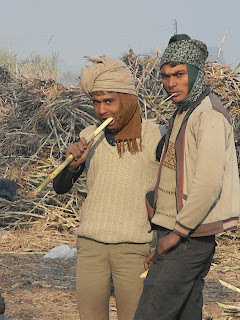When you live in North India, you hear as much about Uttar Pradesh (UP) and its political tribulations as you meet people from there who have settled in the capital.
UP is also India’s biggest sugar producer and therefore a visit to at least one of the state’s mills imposed itself as a must. But because the state is huge, we decided we would go to a mill ‘neighbouring’ Delhi, or some 4-5 hours journey away, near Muzzafarnagar.
We went in late January, when the winter is slowly giving place to the hot burning sun. Thus, although we started the day covered in shawls and jumpers, we quickly settled for a simple shirt as we made our way through the sunny day.
The most surprising thing was the impeccable conditions of the roads which made the long drive that much more pleasant even though in India, the saying goes that new roads are as quickly destroyed by the inhospitable weather as old roads take time to be rebuilt.

Our first stop was at a cane dropping point, were farmers, once summoned by the local mill, come to drop a pre-determined quantity of their cane that mill trucks will in turn bring to the factory. This system, in theory, reduces the loss of the sugar caused by long bullock-cart journeys from the field to the mill. In reality, however, the cane often remains several hours at the drop off/pick up point before being taken in the truck.
We then decided to visit our friends the gurwale (gur makers) and made a stop at a gur making installation temporarily settled between the side of the road and the far-reaching cane fields. The hot sun combined with the fumes coming out from the precarious machinery created a slightly suffocating atmosphere.
The whole machinery was made to function on the engine of a single tractor. Cane was introduced at one end, and after several crushing processes the juice was extracted and poured into a cement basin where it was boiled and purified in 4 stages.
We tasted the juice and despite the suspicious colour, it turned out to be very good. Although I couldn’t quite manage to finish my glass to the disappointment of our gur making friends.
The visit to the gur mandi (market) was interesting although pretty much nothing was going on. It was full of a various of types of gur (powdered, layered, yellow, white etc) for as many purposes (sweetener, food, alcohol, animal feed). We were very quickly circled by every member of the market as we discussed with them what was going on. They were complaining that they were struggling to sell their products.
We ended at the day at one major mill in the area. The manager, a very friendly and technology savvy sikh (he was juggling between his Blackberry, his Iphone, his Ipad and his Galaxy Tab) took us around the mill. The crushing has only just started to pick up, he told, as he explained the different purposes of the machinery.
At the entrance of the mill, bullock carts drop off the cane. The cane is then taken through a multitude of steps until it is turned into different kinds of sugar.
It is a common sight to see children grabbing some of the cane of the carts.
I have to say that the most amazing thing was that absolutely nothing goes to waste. They produce ethanol, local alcohol, whiskey, co-generation etc. And that’s on top of the many different types of sugar that comes out of these walls. When I mentionned I suffered from iron deficiency, our friend gave me a bag of brown sugar with iron!








No comments:
Post a Comment